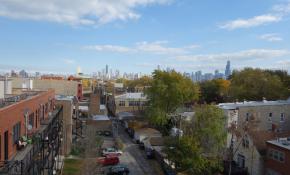About a week after Hurricane Maria hit Puerto Rico, Laura Walker listened in to WNYC for news of an island still without power.
It reminded Walker, WNYC's president and CEO, of how essential radio is when the power's out. She saw it herself after 9/11 took down WNYC's transmitter at the top of the World Trade Center, after 2003's blackout and after Hurricane Sandy.
Of the five public radio stations in Puerto Rico, only one was operating, and it was at half power.
What could her station do to help?
The answer sat thousands of miles away in Alaska. There, several years ago, a public media collaborative built two Radio To Go kits to help them keep broadcasting.
The Corporation for Public Broadcasting heard about CoastAlaska's kits. They got one to New York. And that's where WNYC stepped in. They could add engineers and expertise and get everything to the island.
And it wasn't just because the station knew what loss of power meant. The region is home to a huge number of Puerto Ricans.
"It’s really just about helping family here," Walker said.
They had the people, the equipment and the experience. Now, they just had to get there.

When radio is king
On Sept. 11, 2001, WNYC's FM transmitter sat atop the North Tower of the World Trade Center. The station stayed on the air thanks to the AM transmitter, but it was in jeopardy, too.
Walker remembers walking home that night across the Brooklyn Bridge. About 10 minutes after she got home, she got the call that the AM transmitter was down, too. She called NPR.
"And I said, 'Can you help us? We need your mobile satellite unit.'"
When they got back on the air, they featured news and live call-ins. People needed to talk, said Steve Shultis, WNYC's chief technology officer. At some point, he remembers, the station started playing classical music at night, “just because we felt the public really needed it.”
CoastAlaska's five member stations haven't been through a major disaster. But they're ready for one. The tsunami that hit Southeast Asia in 2004 made them stop and think, said Mollie Kabler, executive director.
"It’s pretty remote. There are no roads to any of our communities," she said. "That could be us if it happened."
CoastAlaska got a grant and built two Radio to Go kits capable of running off a car battery if needed. They're designed to travel by commercial jets, ferry or even fishing boat.
More and more newsrooms are now digital and living across platforms. But when the power behind those platforms goes out? Puerto Rico's GFR Media couldn't print after the hurricane and people couldn't read the news online, so a radio station that managed to stay on read the news.
It's not about the technology, Shultis said, it's about the ability to get people information when they need it.
"There are those catastrophic electric, mechanical failures that can still happen, and there really, radio is king," he said. "It’s the airwaves."
There and back again
CPB asked Kabler where she bought their kits. We built them, she said, then offered to send them to Puerto Rico. She even got Alaska Airlines to cover the cost of getting them to New York.
Shultis learned of the plan at the end of September, and he reached out to two WNYC employees he thought could handle the task.
"They both immediately said yes."
Dannie Raghunath works for WNYC full-time, and Peter Polanco works part-time. Polanco was familiar with the work itself. After Hurricane Sandy took out the station's AM transmitter, Polanco spent 11 months getting that site up and running again.
The engineers found it wasn't that hard to get on the island. But it was much tougher to get off again. The earliest return flight they could get back was Oct. 16. Go ahead and book them, Shultis said. Surely something would come through before then.
It didn't.
Hotels also all had waiting lists, and finding the two a place to stay was equally tricky.
The men finally flew in last Thursday with seven pieces of equipment weighing 300 pounds. WNYC added 300 feet of transmission line to connect the transmitter to the antennae. Their primary mission was to get WIPR back on the air.
Their secondary mission was to provide a third-party assessment of the damage to two other transmission sites on the island, one just outside of San Juan and another about three hours to the west.
By Sunday night, WIPR was up and running through an antenna at the top of the station's San Juan building. The two engineers flew back into New York on Monday.
Still, pretty much everyone views this as just the beginning.
Short-term solutions
Public radio stations in Alaska got equipment to a station in New York, which took that equipment to a station in San Juan and got them on the air again. Behind the scenes, the Latino Public Radio Consortium helped connect the equipment with the engineers with the stations and people on the ground.
All of that is a short-term solution, said Magaly Rivera, Latin Public Radio Consortium's executive director.
Next, she said, the remaining stations need complete assessments on the damage to their transmission sites and equipment, as well as what the hurricane has done to those news operations and newsroom staffs, who are dealing with the hurricane's devastation, too.
This is typically fundraising season for Puerto Rico public radio stations, and that's not happening now either. LPRC launched a Go Fund Me to raise cash to help the stations get back on the air again. Earlier this month, several broadcaster groups announced they'd be sending 10,000 battery operated radios to Puerto Rico. And Radio Ambulante is holding a benefit show for Puerto Rico later this month.
CoastAlaska just got a second kit to WMFE in Orlando, and that station plans to get it to a station in Mayaguez, Kabler said.
WNYC isn't done yet, either. In addition to continued coverage, Walker said, they're planning to send a reporter and producer to Puerto Rico for a year to cover the island's recovery.
"It is really about the longevity," she said, "and staying and reporting."










